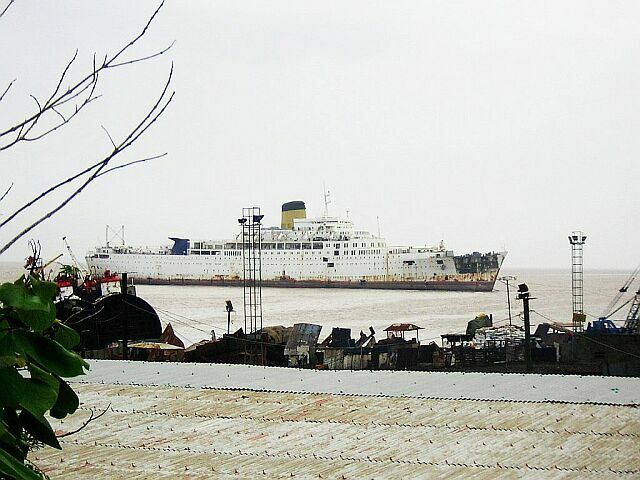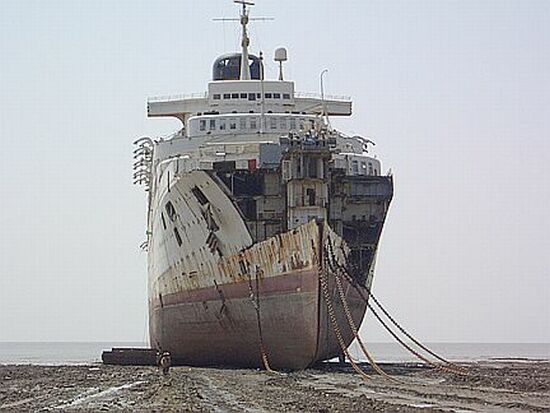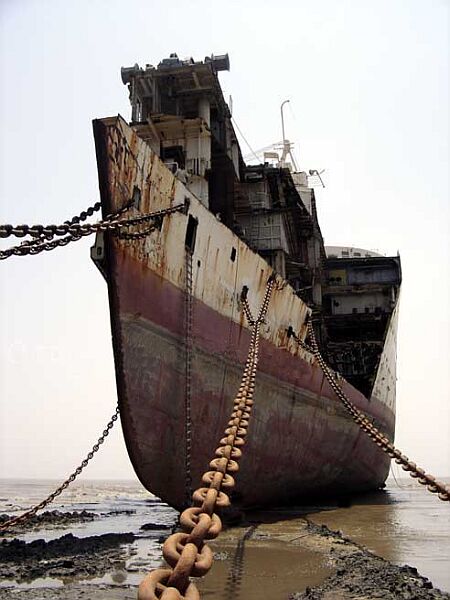The RMS Mauretania entered service a few months after her sister, Lusitania, starting her maiden voyage on November 16, 1907, and battling her way across the Atlantic through frightful seas.
 During her career, she proved to be slightly faster than the Lusitania; she was also slightly longer (790 feet instead of 787) and larger (31,938 tons instead of 31,550.47).
During her career, she proved to be slightly faster than the Lusitania; she was also slightly longer (790 feet instead of 787) and larger (31,938 tons instead of 31,550.47).The Mauretania – a great ship – the story…
In 1897 the Nordeutscher Lloyd ship Kaiser Wilhelm der Grosse took the Blue Riband from Cunard’s Campania and Lucania. Thereafter German ships held the trophy without challenge. It was not until 1902 that negotiations began between the Government and Cunard with a view to building two superliners, the Lusitania and Mauretania, capable of winning back and holding the Blue Riband for Britain.
By 1903 an agreement had been reached whereby the Goverment would lend £2,600,000 to Cunard to build two ships capable of 24 to 25 knots. In addition they agreed to make an annual payment to Cunard on the condition that the two ships were capable of being armed and that the Government would have a claim on their services in times of national emergency.
The Mauretania was launched by the Duchess of Roxburghe. It was a quadruple screw ship driven by direct-drive steam turbines.
The Mauretania passing the Lusitania.
Although the propulsion machinery was identical to that of the Lusitania two modifications gave the Mauretania a slight edge over its sister. The diameter of the propeller blades was slightly larger and the turbines were fitted with more rows of blades.
The Mauretania made its maiden voyage from Liverpool on 16 November 1907. Severe storms and heavy fog hampered the first voyage but the ship still arrived in New York in good time on 22 November. On 2 May 1908 the ship had left Liverpool when it was thought to have hit a submerged object.
 Despite the propeller blades being damaged, Cunard took advantage of the situation and took the opportunity to replace both inner shafts with four bladed propellers. A refit was also carried out at Canada Graving Dock later that year. The subsequent voyage left Liverpool on 23 January 1909. By April of that year the Mauretania had captured both eastbound and westbound records and retained the Blue Riband for 20 years, until July 1929.
Despite the propeller blades being damaged, Cunard took advantage of the situation and took the opportunity to replace both inner shafts with four bladed propellers. A refit was also carried out at Canada Graving Dock later that year. The subsequent voyage left Liverpool on 23 January 1909. By April of that year the Mauretania had captured both eastbound and westbound records and retained the Blue Riband for 20 years, until July 1929. By 1909 the public were looking for faster crossings and once at their destination, a speedy land journey. As a result it was inevitable that ports closer to London than Liverpool were required, and soon Fishguard was developed as a port of call for Atlantic liners.
By 1909 the public were looking for faster crossings and once at their destination, a speedy land journey. As a result it was inevitable that ports closer to London than Liverpool were required, and soon Fishguard was developed as a port of call for Atlantic liners.The Mauretania was the first Cunard liner to use this port, on 30 August 1909. At the end of 1909 the ships first Captain, John T. Pritchard, retired and Captain William Turner assumed command. The reputation of the ship attracted several prominent passengers. On a voyage during December 1910 Prince Albert and Prince Radziwell were amongst the passengers, along with Mr. Carlisle, the managing director of Harland and Wolff. In June 1911 the ship brought thousands of visitors to Britain for the Coronation of King George V.


Public rooms.
In December 1913 the Mauretania returned to Liverpool for its annual overhaul, part of which involved work on the main propulsion turbines. On 26 January 1914, whilst men were working on the turbine blades, one of the gas cylinders exploded. Four men were killed and six were injured.
The resulting fire was extinguished and the main damage was confined to the blades in the starboard turbine. The ship was not ready to rejoin the Atlantic service until March of that year. When Britain declared war on Germany, on 4 August 1914, the ship was on its way to New York. At the last minute the ship was diverted to Halifax and the Admiralty sent out an order requisitioning the ship as an armed merchant cruiser, as soon as it returned to Liverpool. On 11 August, however, the Mauretania and the Lusitania were released from Government duties.
The reduced demand for transatlantic passages meant that the ship was laid up at Liverpool on 26 August. After the loss of the Lusitania in May 1915 the Mauretania was required to return to service. Before it did, however, the Admiralty requisitioned the ship to transport troops during the Gallipoli campaign, later in May. During this period the ship made several voyages to Mudros Bay island of Lemnos, the Allied base for operations in the area. On one of these voyages the Mauretania was attacked by a submarine but managed to avoid the torpedo, largely due the ship’s high speed. At the end of August it returned to Liverpool and was fitted out as a hospital ship. It then left Liverpool on 21 October to assist with the evacuation of the wounded from Gallipoli. The Mauretania made several further voyages as a hospital ship and completed its last voyage on 25 January 1916.
George V and Queen Mary inspecting the RMS Mauretania.
This, however, was not the end of the ship’s war service. On 29 September it was requisitioned again to carry Canadian troops. In October-November 1916 it made two voyages from Liverpool to Halifax carrying Canadian troops bound for France. After this it was laid up on the Clyde until 1918.
 In March 1918 it was again used as a troopship carrying over 30,000 American troops before the Armstice in November. After the end of the war the ship was used in the repatriation of American and Canadian troops. From 12 December it was decided that the Mauretania would now sail from Southampton and call at Cherbourg on its way to New York. It made its final trooping voyage on 28 June 1919 and was then refitted at Southampton.
In March 1918 it was again used as a troopship carrying over 30,000 American troops before the Armstice in November. After the end of the war the ship was used in the repatriation of American and Canadian troops. From 12 December it was decided that the Mauretania would now sail from Southampton and call at Cherbourg on its way to New York. It made its final trooping voyage on 28 June 1919 and was then refitted at Southampton.On 21 September 1919 it sailed from Southampton on its first commercial voyage since World War One began. An overhaul, planned for 1920, was delayed as the demand for passenger services to Europe from America was so great. Whilst docked at Southampton, on 22 July 1921, a fire broke out on board. The fire spread quickly and required the efforts of both the fire brigade and crew to extinguish it. The damage caused was confined to the first class cabin area. It was decided to send the ship back to the builder’s yard for an overhaul and the opportunity would be taken to convert from coal to oil burning. By March 1922 the Mauretania had resumed its usual service.
Painted white for cruise service.
On 25 July the ship broke its pre-war Atlantic speed record. The ships average speed was now above 26 knots. In January 1923 the ship was chartered by an American travel company and made a Mediterranean cruise.
Another overhaul was undertaken in November but due to industrial disputes it was decided to complete the work at Cherbourg. Despite a difficult journey, being towed by tugs, the ship reached Cherbourg and the work was completed quickly.
 In 1924 the Cowes Harbour Commission complained about the Mauretania’s speed as it left the Solent. The heavy wash created had flooded Cowes main street and caused considerable disruption.
In 1924 the Cowes Harbour Commission complained about the Mauretania’s speed as it left the Solent. The heavy wash created had flooded Cowes main street and caused considerable disruption.The Government decided that the pilot was to blame. A refit in 1928 saw the ship’s furniture and decor modernized. New ships built for the Nordeutscher Lloyd line, however, were now posing a threat to the Mauretania’s domination of the Atlantic.
Crew members are seen — the demarcation in class was evident. America barely did better. Equality aboard a passenger ship for African-Americans didn’t happen until this century and that’s questionable. The ships Europa and Bremen were launched in August 1928. The Bremen soon broke the Atlantic speed record but the margin of time was quite small.
On 27 November 1929 the ship collided with a train ferry near Robbins Reef, after leaving New York. Luckily no one was injured but the ships bows were damaged.
The hole in the bows, however, was repaired within 24 hours.
After a winter overhaul it returned to service in February 1930 and during the following years concentrated mainly on cruising.
 The Mauretania made its final passenger sailing from Southampton on 30 June 1934, the day Cunard and White Star Lines merged. After two cruises to the West Indies it returned to Southampton on 2 October. The completion of the Queen Mary and the merger with White Star meant that the fleet had to be reduced.
The Mauretania made its final passenger sailing from Southampton on 30 June 1934, the day Cunard and White Star Lines merged. After two cruises to the West Indies it returned to Southampton on 2 October. The completion of the Queen Mary and the merger with White Star meant that the fleet had to be reduced.The Mauretania was now outdated and was soon laid up at Southampton.
The ship was purchased on 3 April 1935 by Metal Industries Ltd. of Glasgow for scrap.
All the fixtures and fittings were auctioned on 14 May at Southampton Docks. On 1 July the ship left for the Tyne. On 3 July it reached the Firth of Forth and was then moved to Rosyth for dismantling.
The question of the week: will the SS United States and the QE 2 end up on the beaches of India. Look at the horror that awaits the great liners!
Alang India — the burial ground of great liners and ships.



Photograph © 2005 - I Royle











No comments:
Post a Comment